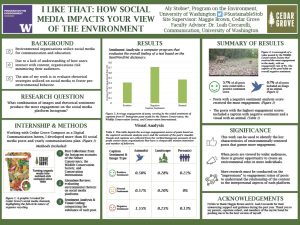I Like That! How Social Media Impacts Your Views of the Environment
Social media is evolving as a critical tool for information dissemination, interpersonal interaction, and news sourcing. As environmental organizations continue to utilize these platforms as a method of environmental communication, it is important to evaluate the best practices for fostering an environmental ethic in the wider population. The purpose of this study was to determine the most effective rhetorical strategies for communicating environmental topics on social media platforms, such as Instagram. To accomplish this task, I collected Instagram posts from conservation organizations, categorized each post based on the attached visual, and evaluated the captions for their overall rhetorical sentiment. Each sentiment score was compared with the amount of engagement, or likes and comments, a post received. By measuring each post’s engagement, I attempted to utilize this score as a proxy for each user’s engagement in proenvironmental behavior. Findings show that the Instagram posts with overall negative sentiment scores received a higher amount of engagement than posts with a positive or neutral sentiment score. The interpersonal nature of social media, compounding rhetorical strategies, and the features of social media platforms are the most significant reasons behind this result. While textual rhetoric is impactful, it is vital to understand the implications of visual communication on social media platforms. Utilizing a variety of rhetorical sentiments paired with a relevant graphic is the most effective solution for gaining engagement and thus fostering pro-environmental behavior.
